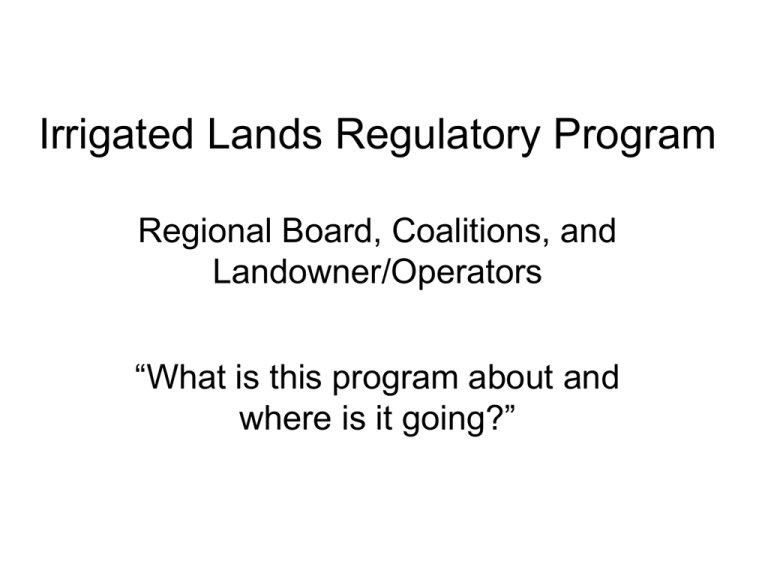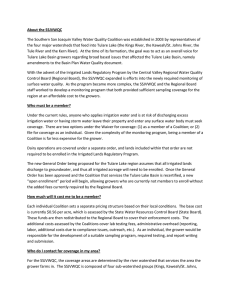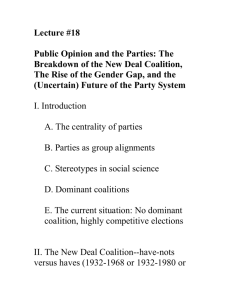Irrigated Lands Regulatory Program Regional Board, Coalitions
advertisement

Irrigated Lands Regulatory Program Regional Board, Coalitions, and Landowner/Operators “What is this program about and where is it going?” Mark Introductions: • Mark Larsen; General Manager – Kaweah Delta Water Conservation District – Manage the Kaweah River Sub-watershed of Coalition • Dave Orth; General Manager – Kings River Conservation District – Chairman of the Steering Comm. of the Coalition • Southern San Joaquin Valley Water Quality Coalition - Kings, Kaweah, Tule, and Kern Watersheds. Mark What is the Irrigated Lands Regulatory Program? • California Water Code: …potential to discharge waste into waters of the state is allowed only under a permit. • State Law (Porter-Cologne Water Quality Act) and Federal Clean Water Act granted a general exemption to irrigated agriculture. • Exemption expired in 2001 New law in 1999 • Senate Bill 390 passed in 1999 • Regional Board authorized to “waive” requirements provided – Not against the public good – Waiver does not exceed 5 years – Waiver is Conditional • Present “waiver” terminates in 2011. What is a Discharge? Who is a Discharger? • Discharge – Irrigation return flow – Tail water – Operational spills – Storm water runoff – Subsurface drainage • Discharger – flows from discharge enter surface waters of the State Mark What is the current structure? • Landowner/Operators can comply individually, or join Coalition. – Individually; Waste Discharge Requirement permit. – Coalition; coverage is for a region for management and cost effectiveness. Mark What are the Goals of the Program? • Identify water quality impacts to surface water by Ag. • Identify constituents causing the impact. • Identify where wastes were discharged, lands that contributed. • Implement Best Management Practices that will prevent impact. Dave Coalition Responsibilities • Southern San Joaquin Valley Water Quality Coalition formed in 2002 • Approved by the Central Valley Regional Water Quality Control Board. • Coalition Monitoring and Reporting Plan approved by the Regional Board. • Landowners enlisted for participation. • Surface waters monitored for impacts. • Reporting of conditions to RB. • Communicate and coordinate with Participants. The Southern San Joaquin Valley Water Quality Coalition •Kings River Conservation District •Kings River Water Association •Kaweah-Delta Water Conservation District •Kaweah and St. Johns Rivers Association •Tule River Association •Kern County Water Association Monitoring Results July 2004 – October 2009 • Number of Sites - 35 • Number of Samples Taken - 310 • Number of Exceedances - 90 – Algal – 48 (43 on Kings) – Sediment - 7 – Other - 35 • Number of Management Plans – 2 – Tule River @ Road 92 – Kern River @ Main Drain Mark Landowner Responsibilities • • Evaluate lands. Review options to comply with Program. – – – • • • No action Individual Option – Waste Discharge Requirement Coalition Option – must “knowingly elect” to participate Reduce potential to discharge. Follow Best Management Practices. Coordinate with Coalition if issue arises. Dave What is the Future of the Irrigated Lands Regulatory Program • Long-Term Program to replace Waiver when it expires in 2011 • Regional Board is conducting a CEQA analysis of 5 alternatives – Alt. I – no change – Alt. II – Coalitions (with Groundwater) – Alt. III – Individual Farm Mgt Plans (direct with RB or lead agency) – Alt. IV – Individual WDR – regional monitoring – Alt. V - Individual WDR Key Questions/Issues • What is the point of Discharge into Groundwater? • What level of GW Quality monitoring will be required? • Will local GW Management Plans be permitted to meet RB requirements? • Will Coalitions accept the expanded responsibility? Dave Conclusion • Program strengths. • Program concerns. • Direction.





